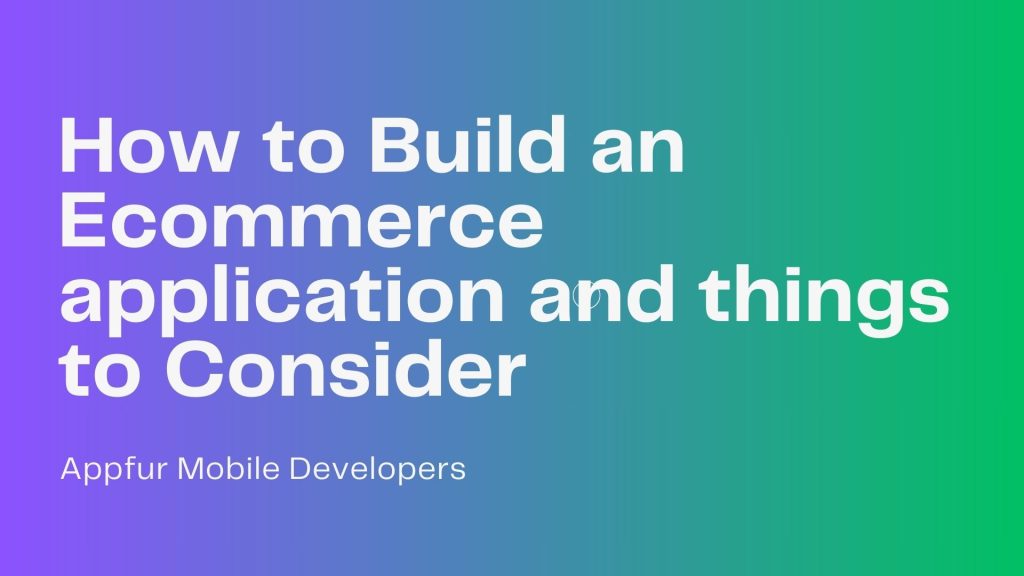
Did you know that mobile commerce will reach $415.93 billion of total retail sales in 2022 and resume its growth after a post-pandemic dip in 2023 until it reaches 8.7% in growth by 2026.
creating an e-commerce application has become essential for businesses looking to tap into the vast online market. Whether you’re a startup aiming to sell products or an established business transitioning to the digital realm, building a robust e-commerce app can seem daunting. However, with the right approach and tools, the process can be manageable and rewarding. In this blog post, we’ll walk you through the key steps involved in building an e-commerce application.
Step 1: Define Your Goals and Target Audience
Before diving into development, it’s crucial to define the goals of your e-commerce application. Ask yourself:
- What products or services will you sell?
- Who is your target audience?
- What problem does your app solve for your customers?
By understanding your goals and audience, you can tailor your app’s features and design to meet their needs effectively.
Step 2: Research the Market and Competition
Conduct thorough market research to understand the current trends, customer preferences, and competitor offerings. Analyze:
- Competitor Apps: Identify strengths and weaknesses in their functionality and design.
- Market Trends: Stay updated on emerging technologies, design styles, and consumer behaviors.
This research will help you carve out a unique value proposition for your e-commerce app.
Step 3: Choose the Right Technology Stack
Selecting the right technology stack is critical for the performance and scalability of your e-commerce application. Here’s a breakdown of essential components:
- Frontend Technologies: Consider using frameworks like React, Angular, or Vue.js for a responsive and dynamic user interface.
- Backend Technologies: Popular options include Node.js, Ruby on Rails, Django, or PHP with Laravel.
- Database: Choose a reliable database like PostgreSQL, MySQL, or MongoDB to store product information, user data, and transactions.
- Payment Gateway: Integrate secure payment solutions such as Stripe, PayPal, or Square for handling transactions.
The right stack will depend on your specific requirements, so choose technologies that align with your team’s expertise and your project needs.
Step 4: Design the User Experience (UX)
User experience is paramount in e-commerce. A well-designed app should be intuitive, engaging, and easy to navigate. Here are some design considerations:
- Wireframing: Start with wireframes to outline the app’s layout and flow. Tools like Figma or Adobe XD can help visualize the user journey.
- Responsive Design: Ensure your app is mobile-friendly, as a significant portion of e-commerce transactions occur on mobile devices.
- Visual Hierarchy: Use colors, fonts, and images effectively to guide users through the app and highlight important features like call-to-action buttons.
Prioritize user testing during the design phase to gather feedback and refine the interface based on real user experiences.
Step 5: Develop Core Features
An e-commerce application typically requires several core features. Here’s a list of essential functionalities to include:
- User Registration and Authentication: Allow users to create accounts and log in securely.
- Product Catalog: Create a visually appealing and easily navigable product catalog with filters for categories, prices, and more.
- Shopping Cart: Implement a shopping cart feature that allows users to add, remove, and modify items before checkout.
- Checkout Process: Design a streamlined checkout process, minimizing the number of steps to complete a purchase.
- Payment Integration: Ensure secure payment processing through a reliable payment gateway.
- Order Tracking: Enable users to track their orders post-purchase.
- User Reviews and Ratings: Incorporate a review system to build trust and provide social proof.
Focus on building a Minimum Viable Product (MVP) first, which includes the essential features to test the market and gather user feedback.
Step 6: Implement Security Measures
Security is critical for any e-commerce application, as you’ll be handling sensitive customer information. Here are some best practices:
- SSL Certificate: Ensure that your application uses HTTPS to encrypt data transferred between the user and the server.
- Data Protection: Implement secure storage and management practices for user data.
- Fraud Detection: Utilize tools and algorithms to identify and prevent fraudulent transactions.
- Regular Updates: Keep your software and dependencies updated to protect against vulnerabilities.
By prioritizing security, you can build trust with your customers and protect your business.
Step 7: Test Your Application
Thorough testing is crucial to ensure that your e-commerce application functions smoothly and is free of bugs. Conduct various testing types:
- Functional Testing: Verify that all features work as intended.
- Performance Testing: Assess how your app performs under heavy traffic and load.
- Usability Testing: Gather feedback from users to identify areas for improvement.
- Security Testing: Conduct penetration testing to identify potential security vulnerabilities.
Testing helps you deliver a polished product and improves user satisfaction.
Step 8: Launch Your Application
After extensive testing and refinement, it’s time to launch your e-commerce application. Here are a few tips for a successful launch:
- Marketing Strategy: Develop a marketing plan to promote your app. Utilize social media, email marketing, and SEO strategies to reach your target audience.
- Analytics Setup: Integrate analytics tools like Google Analytics to track user behavior and app performance post-launch.
- User Support: Prepare a support system to address customer inquiries and issues promptly.
A well-executed launch can create buzz and drive initial traffic to your application.
Step 9: Gather Feedback and Iterate
Once your e-commerce application is live, continuous improvement is essential. Encourage users to provide feedback and monitor analytics to identify trends and areas for enhancement. Regular updates and feature additions will keep your app relevant and improve user engagement.
Conclusion
Building an e-commerce application involves careful planning, design, development, and ongoing improvement. By following these steps and staying focused on your users’ needs, you can create a successful e-commerce app that not only meets market demands but also drives your business forward. Remember, the key to success lies in understanding your audience, being adaptable, and continuously striving to enhance the user experience. Happy building!
We design and build high-quality, scalable mobile apps tailored to your needs.
Let’s talk! Message us on WhatsApp now: Click Here
Your next big app starts here!
